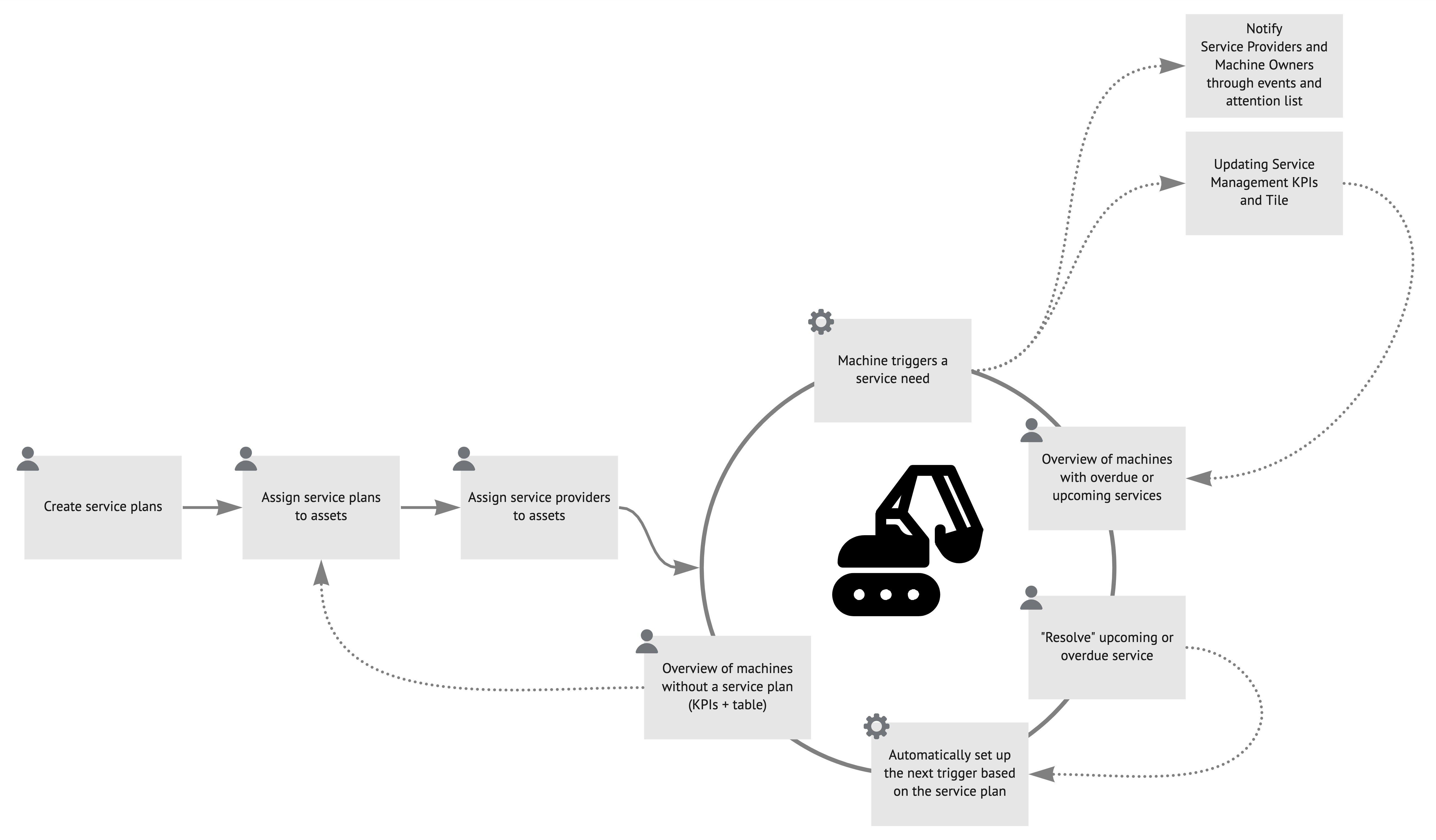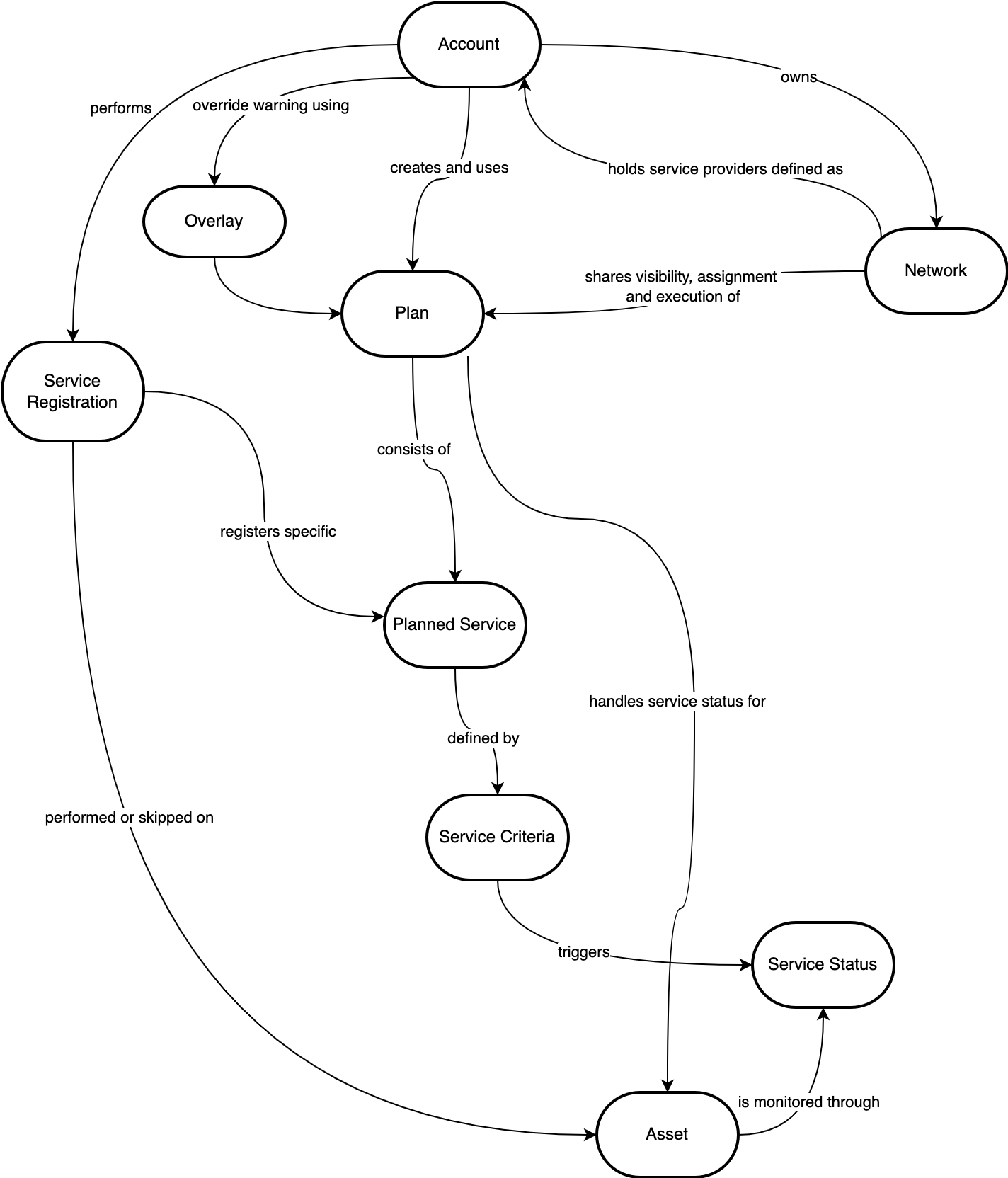Our Service Management API provides a list of APIs enabling service providers and machine owners in maintaining the service cycle of assets.

The document is intended for developers, who wants to integrate systems, write client libraries or other interactions on an API-level.
Available with the Service Management appThis API is available for customers that have acquired a license for the Service Management capability.
Concepts
Service Management is built on the following concepts
- An asset is a trackable piece of equipment e.g. a machine or an accessory.
- A service plan is a collection of planned services, which defines the criteria for service intervals e.g. based on operating hours.
- A service plan is assignable to an asset.
- A service plan is owned by the creating account.
- A service plan is assignable by the service plan owner and if assigned, visible to the asset owner.
- A service plan can be shared with other accounts by using a service network.
- A service plan can be published for a specific brand and model, making the service plan available to the asset owner when matching brand and model of an owned asset.
- A service provider is capable of carrying out asset services. The service provider is an account and defined by the account's id. A service provider is assignable to an asset in conjunction with a service plan.
- The service network forms a network of service plans assignable to assets, and service providers capable of carrying out services on the assets.
- The service network's owner can add and remove both the service providers and service plans within the network, and thereby granting the service provider access to servicing assets under an assigned service plan.
- An overlay can be applied to a service plan within a service network by a service provider to override the service plan's warning thresholds. Only assets having both the service plan and the service provider will be affect by the overlay.
Workflow operations
- Service plan assignment forms a link between a service plan, a service provider and an asset. The service plan dictates when services should be performed for the asset. The service provider is responsible for performing services on the asset. Multiple service plans can be assigned to an asset.
- The service plan is activated for an asset when both service plan and service provider have been assigned.
- Pending (overdue or upcoming) services are resolved or cleared by a service registration, which marks pending services as performed or skipped at the time of registration. The service registration marks individual services performed. A service registration can also be used to register a service performed outside the schedule service window.
Constraints
- Visibility of an assigned service plan is always limited to the asset visibility and is defined as
- Service plans are visible to asset owner and service plan owner.
- Service plans within a service network are visible to the network owner and service providers within the network.
- A service provider is removed from a service plan assignment if the service provider's asset visibility is revoked and not restored with 4 hours.
- There can only be one service provider assigned to an asset per service plan assignment.
- An account can create any number of service networks. The creating account of the service network will be the network owner.
- An account can only assign itself as service provider.
- A public service plan can be assigned and provided for by the asset owner if the public service plan is not assigned and provided for by an other service provider.

Relationship between concepts
Basic steps
Try it out using the following basic steps
1. Enable Service Management
Contact us to acquire a license for the Service Management capability. After acquiring the capability, start off by creating a Service Network. You can decide which of your accounts should be part of your network. The service network owner must be hierarchically above your service providing accounts as shown in the figure below. After enablement all service providers will have access to the Service Management app within Manager.

2. Add a service plan
Visit the Manager application to create a service plan.
Locate the Service Management app and navigate to Configuration and then "Manage Service Plans" tab.
Create a new service plan by clicking "Create service plan" in the top right corner of the "Manage Service Plans" tab.
Fill in the name of your service plan and add one or more services by clicking "Add service" located in the bottom right corner of the app. Afterwards create it by clicking "Create".
3. Assign service plan & service provider
Now it's time to use the Service Management API.
For this step you will need an API token. If you don't have one then follow the our Access IRIS APIs guide to obtain one.
Locate your newly created service plan by getting available service plans from /plans
curl --location --request GET 'https://iris.trackunit.com/api/service-management/v2/plans' \
--header 'Authorization: Bearer <<YOUR_TOKEN>>'Verify the response body contains the service plan you just created in the Manager application.
{
"servicePlans": [
{
"id": "3f3543f7-9c58-4d6c-8c67-ce48349bc46d",
"metadata": {
"createdAt": "2021-08-25T19:55:34.879147Z",
"updatedAt": "2021-08-25T19:55:34.879147Z"
},
"plannedServices": [
{
"id": "97e7ac2d-59e7-4559-909b-56ff68eba616",
"serviceCriteria": {
"distanceCriteria": null,
"timeIntervalCriteria": null,
"cumulativeOperatingHoursCriteria": {
"id": "ca618f3a-08f2-4694-aa55-4106afb2333b",
"notifyHoursBefore": 50,
"serviceHours": 500
}
},
"recurrent": true,
"offset": false
}
],
"name": "My first service plan",
"isPublic": false
}
]
}Assign the service plan to one of your assets. Capture the id of the service plan you want to assign from the response listing your service plans - in the example above the id is 3f3543f7-9c58-4d6c-8c67-ce48349bc46d. Also locate the id of the asset you want to assign your service plan to.
You can locate the id of your asset by getting a list of your machines from the Asset API.
curl --request GET \
--url https://iris.trackunit.com/api/asset/v1beta1/assets \
--header 'accept: */*' \
--header 'authorization: Bearer <<YOUR_TOKEN>>{
"totalPages": 1,
"totalElements": 2,
"number": 0,
"size": 20,
"numberOfElements": 2,
"content": [
{
"id": "00000000-0000-0000-0000-000001427023",
"assetType": "MACHINE",
"type": "AWP/Scissor lift",
"name": "Asset #1",
"externalReference": "",
"model": "My model",
"brand": "My brand",
"serialNumber": "1234abc",
"productionYear": 2021,
"ownerAccountId": "7045120f-5ee7-4613-9977-7e2d8b01ce8c",
"createdAt": null,
"permissions": {
"edit": false
},
"telematicsDevices": [
{
"id": "199214"
}
]
},
{
"id": "00000000-0000-0000-0000-000001427026",
"assetType": "MACHINE",
"type": "AWP/Boom lift",
"name": "Asset #4",
"externalReference": "",
"model": "My model",
"brand": "My brand",
"serialNumber": "4567abc",
"productionYear": 2018,
"ownerAccountId": "01a0dcc2-4365-4cd6-9450-ea271133c047",
"createdAt": null,
"permissions": {
"edit": false
},
"telematicsDevices": [
{
"id": "199211"
}
]
}
]
}Assign the service plan to your asset.
curl --location --request PUT 'https://iris.trackunit.com/public/api/service-management/v2/plans/assignments' \
--header 'Content-Type: application/json' \
--header 'Authorization: Bearer <<YOUR_TOKEN>>' \
--data-raw '{
"add": [
{
"assetId": "00000000-0000-0000-0000-000001427023",
"servicePlanId": "3f3543f7-9c58-4d6c-8c67-ce48349bc46d",
"provideFor": true
}
]
}'Response code 200 means the service plan has been assigned to the asset and your account is the service provider.
The service plan is now active for the asset.
4. Resolve pending services
You are able to retrieve a list of asset by service status using /plans/assignments/service-status/:serviceStatus/assets. Depending on what service criteria you have added to your plan, your asset's service status will either be in service status PLANNED, UPCOMING or OVERDUE. In this example it is in OVERDUE.
curl --location --request GET 'https://iris.trackunit.com/api/service-management/v2/plans/assignments/service-status/OVERDUE/assets' \
--header 'Authorization: Bearer <<YOUR_TOKEN>>'Response
{
"assetIds": [
"00000000-0000-0000-0000-000001427023"
]
}After the overdue services has been performed, you can resolve the overdue service by creating a service registration.
To perform the registration you will need call /plans/assignments/service-registrations with the id of the asset and id of the planned service perform, which can be located in the get service plan response. In this example the asset id is 00000000-0000-0000-0000-000001427023 and planned service id is 97e7ac2d-59e7-4559-909b-56ff68eba616.
curl --location --request POST 'https://iris.trackunit.com/api/service-management/v2/plans/assignments/service-registrations' \
--header 'Content-Type: application/json' \
--header 'Authorization: Bearer <<YOUR_TOKEN>>' \
--data-raw '{
"assetIds": [
"00000000-0000-0000-0000-000001427023"
]
}
{
"assetId": "00000000-0000-0000-0000-000001427023",
"performedAt": "2021-09-20T06:09:09.621736Z",
"servicesPerformed": [
{
"plannedServiceId": "97e7ac2d-59e7-4559-909b-56ff68eba616"
}
]
}'You have now successfully completed a service cycle. If your service plan has further planned services then the next service is now planned and the asset is in service status PLANNED.
Predictions
This feature is only available with certain packages
The Service Management app has the capability of predicting when services are due based on historical usage data. Predicted due dates are calculated using linear extrapolation on the usage of the machine (cumulative running hours/distance) over the last 30 days. They are calculated for all assets configured with service plans and are recalculated daily. If the planned service on an asset has multiple service criteria the prediction will be the first coming date of the calculations. The API response will include the criteria type that is basis for the calculation. If the asset usage drops for an extended period of time and causes the prediction to be too far in the future, the system will clear out the predicted date. To get the predictions call the endpoints for service status, e.g.
curl --request GET \
--url 'https://iris.trackunit.com/api/service-management/v2/plans/assignments/service-status?assetId=00000000-0000-0000-0000-000001427023' \
--header 'accept: application/json' \
--header 'authorization: Bearer <<YOUR_TOKEN>>This will produce a response containing predictions for each planned service like:
{
"plannedServiceStatuses": [
{
"servicePlanId": "14a32d8a-4f2a-4db4-baf9-608b186a6fab",
"plannedServiceId": "5e835878-31c9-4fa8-87fe-e10f98d0fd58",
"serviceProviderAccountId": "44e30abf-f6e8-4bd2-9c51-cb229ee91f02",
"cumulativeOperatingHoursCriteria": {
"criteria": {
"id": "c83cdb68-cf1f-4759-bd09-7f111ff74b5c",
"notifyHoursBefore": 100,
"serviceHours": 2100
},
"triggered": true
},
"timeCriteria": {
"criteria": {
"notifyDaysBefore": 30,
"serviceTime": "2024-04-23T08:10:09.124Z"
},
"triggered": false
},
"triggeredAt": "2023-05-08T15:00:13.464Z",
"status": "OVERDUE",
"name": "500h/12M Recurring",
"predictionCriteria": "CUMULATIVE_OPERATING_HOURS",
"predictedServiceTime": "2023-05-08T15:00:13.464Z",
"predictedAt": "2023-05-08T15:00:13.464Z"
}
]
}The prediction is contained in the following fields:
predictedServiceTime- the expected due datepredictionCriteria- the criteria responsible for the predicted due datepredictedAt- the time the prediction was calculated